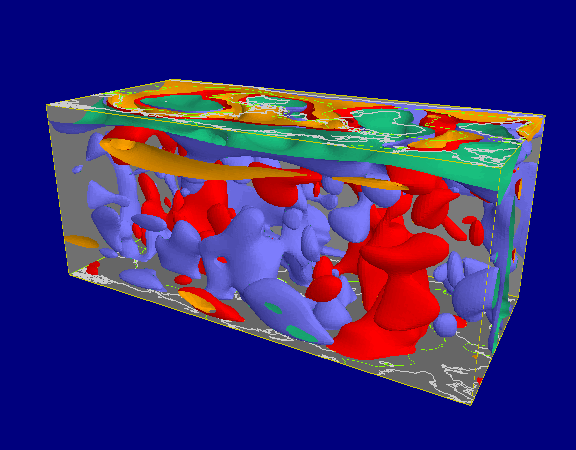-
View the movie
of the computer model demonstrating mantle
convection. This model has been generated using super-computers and
earthquake data.
Okie Dokie.
-
How does this convection influence the spreading
of the sea-floor?
Good grief! I could spend the next year
on this topic! Doing an Internet search on "mantle convection" produces
Case Study: Mantle Convection Visualization at
http://www.acl.lanl.gov/Viz/terra/terra.html
A search of periodicals at http://sciserver.lanl.gov/cgi-bin/search.pl
(you need to search these through some library with access) shows a number
of very erudite articles addressing this topic, including Effects
of water-dependent creep rate on the volatile exchange between mantle and
surface reservoirs by Franck, Siegfrieda; Bounama, Christine at
Universität Potsdam, Projektgruppe ‘Allgemeine Geophysik’, PF 60 16
32, D-14416 Potsdam, Germany, which appeared in the Journal, Physics
of the Earth and Planetary Interiors, Vol: 92, Issue: 1-2, pp. 57-65,
November, 1995. The abstract for this article gives at least some
indication of the complexity involved:
"A parameterized model of mantle convection,
including the volatile exchange between mantle and surface reservoirs,
is used to study the thermal history of the Earth. The influence of dissolved
volatiles on mantle rheology is reformulated. The weakening of mantle materials
is described by a functional relationship between creep rate and water
fugacity. We use flow law parameters of diffusion creep in olivine under
dry and wet conditions. The mantle degassing rate is considered as directly
proportional to the seafloor spreading rate, which, in turn, is dependent
on the mantle heat flow. To calculate the spreading rate, we assume that
the heat flow under the mid-ocean ridges is double the average mantle heat
flow. The rate of regassing also depends on the seafloor spreading rate,
as well as on other factors such as the efficiency of volatile recycling
through island arc volcanism. Both mechanisms (degassing and regassing)
are coupled self-consistently with the help of a parameterized convection
model under implementation of a different formulation of mantle viscosity.
The model is run for 4.6 Gyr. Time series of average mantle temperature,
volatile loss, mantle viscosity, mantle heat flow, Rayleigh number and
Urey ratio are calculated. The effects of changing initial parameters have
been tested and found negligible for the final results. Mantle water is
outgassed rapidly within a time scale of less than 200 Myr for all numerical
simulations. The present-day values of calculated parameters are in the
generally accepted range."
Similarly, the article Punctuated tectonic evolution of the
earth by Geoffrey Davies of the Research School of Earth Sciences,
Australian National University, GPO Box 4, Canberra, ACT 0200, Australia,
which appeared in the journal, Earth and Planetary
Science Letters, Vol: 136, Issue: 3-4, pp. 363-379, December, 1995
has an interesting abstract:
"The potential of a phase transformation barrier to cause mantle layering
has been incorporated into calculations of the thermal evolution of the
earth's mantle based on parameterised convection theory. A range of possible
behaviors is demonstrated, depending on parameter values, including episodic
layering, long-term layering or no layering. Novel findings are 1-2 Ga
phases that might correspond with major tectonic eras, and that early mantle
overturns may have caused global magmatic and tectonic convulsions. For
the more plausible parameter values, the models are initially layered,
but typically the layering becomes unstable and breaks down episodically
via mantle overturns. Subsequently the models evolve into whole-mantle
convection due to the increasing ability of subducted plates to penetrate
the phase barrier as the mantle cools, consistent with geophysical evidence
against strong layering of the present mantle. The early layering-overturn
cycles may occur on timescales of a few hundred million years. The overturns
replace cooler upper mantle material with hotter lower mantle material,
and would cause global convulsions that potentially correspond with episodes
of crust formation. Such models permit plate tectonics to operate in the
Archean between overturns, though the early crust may record mainly the
effects of overturns, which could generate, aggregate and/or rework large
volumes of mafic crust in a short time. They would help to explain present
degrees of depletion of the mantle in incompatible elements as well as
strong upper mantle depletion in the early Archean. The early convulsions
may have controlled the composition of the atmosphere and frustrated the
development of life."
While not all of this may be readily comprehensible, it's clear that this
mantle convection is a central ingreadient in many models for the evolution
of Earth's crust.
Clearly there is much to learn here. At the UC Berekeley site:
http://www.ucmp.berkeley.edu/geology/tecmech.html, we read that
"Magma continuously wells upwards at the mid-oceanic ridges (arrows)
producing currents of magma flowing in opposite directions and thus generating
the forces that pull the sea floor apart at the mid-oceanic ridges.
As the ocean floor is spread apart cracks appear in the middle of the ridges
allowing molten magma to surface through the cracks to form the newest
ocean floor. As the ocean floor moves away from the mid-oceanic ridge it
will eventually come into contact with a continental plate and will be
subducted underneath the continent. Finally, the lithosphere will be driven
back into the asthenosphere where it returns to a heated state."


